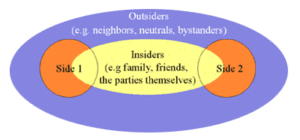
William Ury, coauthor of the well known negotiation book “Getting to Yes”, recently popularized the notion of the Third Side. In a conflict, the Third Side are those who are part of the larger group, community, or organization that support the essential needs of both sides. Collectively, the Third Side offers a bigger perspective to keep focus on what is important.
The Third Side concept is very relevant to our current healthcare debate in the US. There are multiple players involved, each with their own interests. Even though all the stakeholders are part of an interdependent network, healthcare often seems like an intractable problem that will only be solved by major disruption whether technical, political, or otherwise.
But there are signs of hope—the growth of digital therapeutics being one example. Digital therapeutics marry technology with standard treatment approaches in tangible ways. They are apps to manage and direct treatment and are intended to enhance, complement, or potentially replace current therapy. Digital therapeutics differ from pure consumer health apps since they are clinically validated in randomized trials and must receive regulatory clearance when used as a medical device. Seeking regulation provides the potential to be integrated into medical treatment. In addition, it gives them a level of acceptance by other players in healthcare including patients, investors, payors, and pharmaceutical companies.
Digital therapeutics represent an effort to work across traditional boundaries to create something new through partnership. Omada Health and Pear Therapeutics are just two examples of digital therapeutics companies. Some insurance companies provide full or partial reimbursement for Omada’s chronic disease program. Pear has received FDA clearance for one of its applications and recently partnered with Novartis to develop digital therapeutics for schizophrenia and multiple sclerosis.
These efforts represent examples of the Third Side where creative ways are being explored to meet the needs of the parties involved and the community at large. There are many hurdles to overcome and it remains to be seen if digital therapeutics will scale and in fact lower costs, engage patients and physicians, and replace or augment existing drugs more broadly.
Whatever the ultimate outcome, we need to encourage even more Third Side efforts. After all, when it comes to our health, we are all Third Siders.